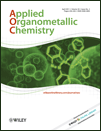Journal list menu
Export Citations
Download PDFs
Full Papers
Catalytic properties of transition metal salts immobilized on nanoporous silica polyamine composites II: hydrogenation†
- Pages: 245-254
- First Published: 03 February 2011

The silica polyamine composites made from poly(allylamine) (PAA) and poly(ethyleneimine) (PEI) were loaded with salts of Pd2+, Ru3+ and Rh3+ and the resulting materials were tested as hydrogenation catalysts. All were active catalysts under mild conditions with the Rh3+ and Ru3+ containing composites showing good selectivity for the reduction of cyclohexadiene to cyclohexene. The nature of the metal sites has been partially elucidated by SSNMR, XPS and TEM.
Synthesis, characterization and microwave-assisted catalytic activity of novel benzimidazole salts bearing piperidine and morpholine moieties in Heck cross-coupling reactions
- Pages: 255-261
- First Published: 14 January 2011
Iron(III), cobalt(II) and copper(II) complexes bearing 8-quinolinol encapsulated in zeoliteY for the aerobic oxidation of styrene
- Pages: 262-269
- First Published: 07 March 2011

A series of Fe(III), Co(II) and Cu(II) complexes of 8-quinolinol were encapsulated into the supercages of zeoliteY and characterized by X-ray diffraction, SEM, N2 adsorption/desorption, FT-IR, UV–vis spectroscopy, elemental analysis, ICP-AES and TG/DSC measurements. The encapsulation was achieved by a flexible ligand method in which the transition metal cations were first ion-exchanged into zeolite Y and then complexed with 8-quinolinol ligand. The metal-exchanged zeolites, metal complexes encapsulated in zeolite–Y plus non-encapsulated homogeneous counterparts were all screened as catalysts for the aerobic oxidation of styrene under mild conditions.
Applications of transition metal complexes containing aminophosphine ligand to transfer hydrogenation of ketones
- Pages: 270-275
- First Published: 21 January 2011
Rigid pyridyl substituted NHC ligands, their Pd(0) complexes and their application in selective transfer semihydrogenation of alkynes
- Pages: 276-282
- First Published: 21 January 2011
Highly efficient amine-based catalytic system for room temperature Suzuki–Miyaura reactions of aryl halides with arylboronic acids
- Pages: 283-288
- First Published: 21 January 2011

A primary amine-based catalytic system exhibited excellent activity in the room temperature Suzuki–Miyaura reactions of aryl halides with arylboronic acids in aqueous media. The efficiencies of the ligands follow the order: (C6H5)3CNH2 > C6H5CH2 NH2 > C6H5 NH2 > C6H11 NH2 which is in accordance with the palladacycle forming capacity of the respective ligands.
The synthesis of non-symmetrical stilbene analogs of trans-resveratrol using the same Pd catalyst in a sequential double-Heck arylation of ethylene
- Pages: 289-293
- First Published: 06 January 2011
5-Carboxymethyl-2-(4-methylthiophenyl)-1,3,2-dioxaborolan-4-one: synthesis, characterization and application in enantioselective reduction of ketones
- Pages: 294-297
- First Published: 14 January 2011
Synthesis, characterization and cytotoxic activity of new diorganotin(IV) complexes of N-(3,5-dibromosalicylidene)tryptophane
- Pages: 298-304
- First Published: 21 January 2011
An efficient one-pot synthesis of 2-benzylpyrroles and 3-benzylindoles
- Pages: 305-309
- First Published: 10 January 2011
Bulk solvent-free melt ring-opening polymerization of L-lactide catalyzed by Cu(II) and Cu(II)–Nd(III) complexes of the Salen-type Schiff-base ligand
- Pages: 310-316
- First Published: 16 February 2011

A monometallic (Cu2+, 1) and a bimetallic (Cu2+Nd3+, 2) complex based on the Salen-type Schiff-base ligand H2L (H2L = N,N′-bis(3-methoxysalicylidene)ethylene-1,2-diamine) were synthesized and characterized by FT-IR, ESI-MS and X-ray crystallography. The catalysis results showed that the two complexes with different active species, could efficiently catalyze the bulk solvent-free melt ring-opening polymerization (ROP) of L-lactide with moderate molecular weights and narrow molecular weight distributions. Especially for the bimetallic complex 2, the involvement of rare earth ions effectively passivated the catalytic behaviors on the ROP of L-lactide with bigger polymeric molecular weights (Mw and Mn) and better polymerization controllability.
Anion-binding properties of two calix[4]arene derivatives containing two ferrocene imine or ferrocene amine units at the upper rim
- Pages: 317-322
- First Published: 17 February 2011
![Anion-binding properties of two calix[4]arene derivatives containing two ferrocene imine or ferrocene amine units at the upper rim](/cms/asset/7b5abe53-fbb2-4963-9e2c-c811cef40134/mgra001.jpg)
Calix[4]arene derivatives containing ferrocene units at the upper rim have been synthesized and their anion-binding and sensing investigated towards anions such as chloride, bromide and hydrogen sulfate by cyclic voltammetry. Electrochemical studies show that these redox-active ligands electrochemically recognize chloride and bromide anions. These compounds have excellent selectivity for chloride and bromide ions, in the comparison with hydrogen sulfate anion. With ferrocenyl Schiff base calix[4]arene 1 an anodic shift as large as 302 mV is observed on addition of four equivalents of Cl− anion.











